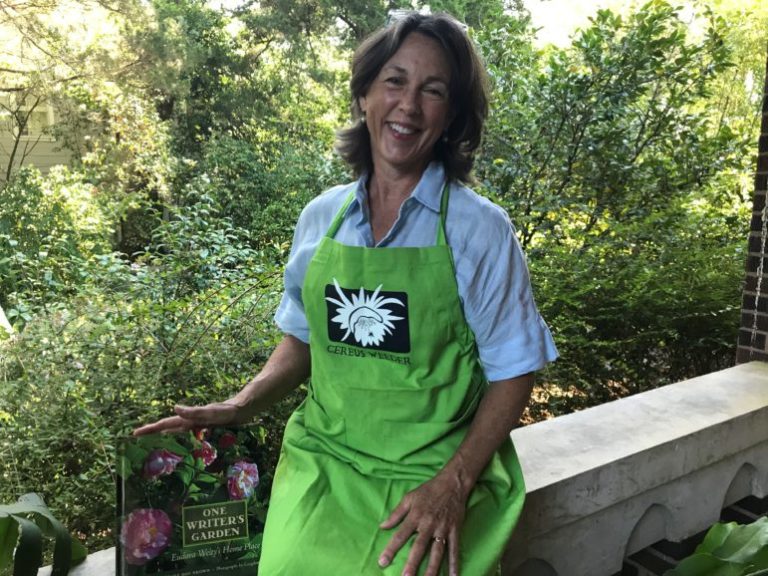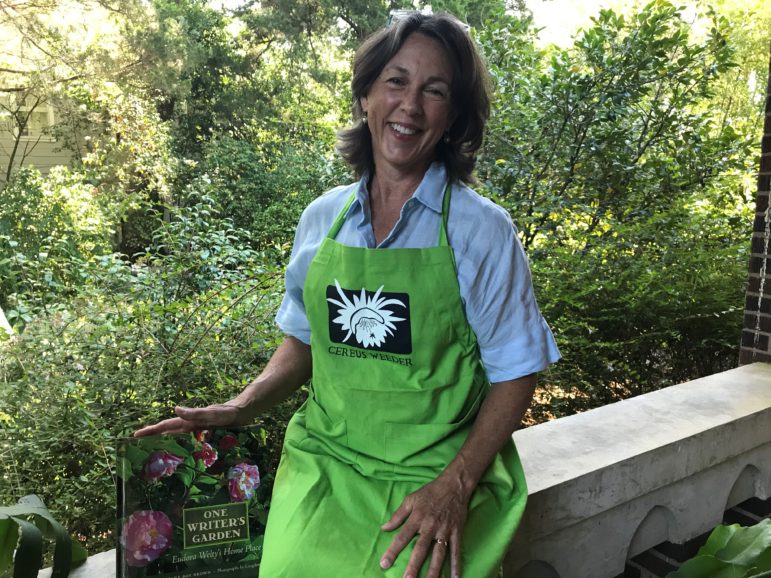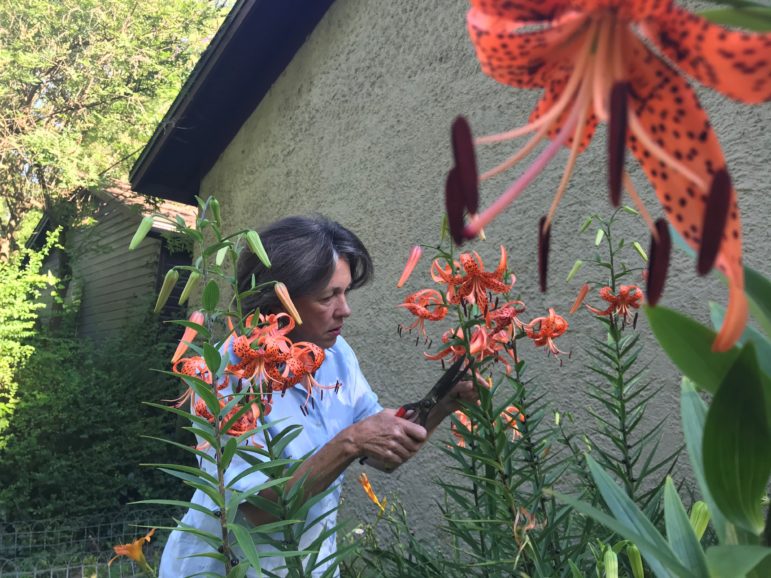

Photo by Sherry Lucas
Susan Haltom, the garden curator who’s been with the Welty Garden for decades and the co-author of “One Writer’s Garden,” retires at the end of June.
Droplets bead on yellow daylilies in the Welty Garden, and morning dew clings to Susan Haltom’s sneakers, but that does nothing to dampen the cheeriness of either.
Haltom whips out pruners and dead-heads yesterday’s blooms, introducing the perennials as originals planted by Eudora Welty’s mother, Chestina, and later, Eudora. Every flower here has a story. Many have multiple tales, trickling through the generations who’ve tended, studied and found solace and inspiration here — Chestina the garden designer, Eudora the writer and plantswoman, Haltom the garden curator and preservationist.
Haltom stops at the stand of tiger lilies for a similar bit of maintenance and a sprinkle of literary references, and she slows past the Nicotiana to consider not only the flowering tobacco plant’s blossoms, but also its place in a Welty story.
Haltom retires at the end of June after more than 25 years here. She’ll continue to advise those entrusted with the garden’s care, including the Cereus Weeders, her core group of volunteers named for the night-blooming cereus plants on the side porch of Eudora Welty House.
From that porch, every view conjures a historical tidbit or botanical observation. The now-towering cedar trees were just six feet tall when they were planted nearly a century ago. The gardenia blooms, just out of fragrance range, would be the first to sniff out a memory.
Haltom had an art degree, gardening mentorship from her mother-in-law (Glenn Haltom of Natchez), and a part-time job at the Mississippi Department of Archives and History when she was tapped to help in the Welty Garden in 1994.
Welty was then in her 80s. “Here’s her big quote to me: ‘I can’t bear to look out the window and see what has become of my mother’s garden,’” Haltom recalls. She’d lost her treasured yard man of 40 years to retirement, his replacement was a “mow-and-blow-and-go guy,” and Welty didn’t know what to do. Haltom didn’t either, at first. But research — including conversations with Welty, and later, her correspondence and photographs, and her mother’s garden notebook — and a strong network of knowledge and support fueled the 10-year garden restoration.
“So, it is authentic, just like Eudora was.”
In one of the earliest hands-on moves, Luther Ott, then Stewpot Community Services director, got a couple of the charity’s clients to help, and, along with Haltom, they pulled poison ivy for four months to uncover some of the garden’s “bones” below. A later part of the restoration, to get to the clubhouse where Welty and friends acted out dramas, required digging out a gully “so solid with bamboo you couldn’t even get through there,” Haltom recalls. “It’s been so much fun!” she laughs. “But I didn’t know in 1994 how I would get there.”
Garden preservation was a new discipline at the time — distinguished by its efforts to retain historic appearance and character, its reliance on historic documentation, its contribution to a historic property’s interpretation and more.

Photo by Sherry Lucas
Yellow daylilies at Welty Garden greet the summer sunshine.
Invaluable in the restoration effort, Haltom says, was advice and support from the Garden Conservancy, Southern Garden History Society (Haltom is a past president), the Welty family, The Eudora Welty Foundation, and particularly Evelyn and Michael Jefcoat of Laurel (“My champions,” she says). The Jefcoats’ support included the arbors and trellises made of tubular steel (rather than rot-prone wood) designed by preservation architect Robert Parker Adams to exactly match photographs of the original garden, restoration of the little clubhouse and Haltom’s book on the garden.
People often ask Haltom if, in those late years before her death in 2001, Welty could look out the window and see the work in progress? “Not exactly,” Haltom says. “But she knew that someone — me — had its best interests at heart.” Most of that time, Haltom would come and work by herself, keeping the garden under observation, then go inside and visit with Welty. She never took notes – until she got in her car to leave, and then she’d scribble madly from memory.
“‘Don’t make the garden something it wasn’t’ — that was Eudora’s dictum to me,” Haltom says. “To me, that meant that she didn’t want it all gussied up, or made into something fine and grand, like Longwood Gardens or the Biltmore House, or any of those bigger gardens that were not what she used as inspiration.
“It was very personal to her. Very personal.” Welty’s mother was the garden designer, focused on spatial relationships and continuity of bloom throughout the year. “Eudora loved looking closely at the flowers, and noting their habit and detail, the fragrance — everything that went toward … the personality of that flower.”
Flowers became character names and keys to a sense of place in Welty’s stories. “She would recognize that flowers, at this time, were ubiquitous, because women had attained the garden. … They didn’t have to be out there every Monday, boiling clothes.
“This time, in the ’20s, women had gotten the vote. And, they were driving automobiles. There were telephones in the home, and they could call each other,” Haltom says, tying the garden’s design and official period of significance, between World War I and World War II, to the era’s innovations, societal changes and women’s growing sphere of influence and community of creativity.
By then, women were sharing plants with each other. Garden clubs grew out of the already decades-old women’s clubs that galvanized personal and community improvement, through education and the charitable works of organized volunteers.
When the Great Depression came, gardens became their places of solace, as well as creativity, Haltom says. “In unusual times, like we’ve got now, many people have gone back to their gardens again. … And, that’s a good thing.”

Susan Haltom checks on the tiger lilies that grow at Welty Garden.
Welty Garden, restored to its 1925-1945 period of significance, opened to the public in 2004. It wasn’t finished, Haltom notes, adding that a restored historic garden never is. It’s always changing, as trees grow and the canopy changes. Preservation and maintenance of a historic garden, different from landscape maintenance, is an ongoing process requiring attention to detail. The garden survived the Great Depression and carried the Welty women through many hard times; she can’t help but worry about its future in the face of budget cuts.
Jessica Russell, in the relatively new MDAH position of garden projects specialist at Eudora Welty House & Garden, takes up the garden focus role. Russell helped launch an Instagram account highlighting the garden’s “parade of bloom” (in Welty’s words), boosted the garden’s presence in the redesigned website that now includes a colorful Bloom Calendar, and worked with Haltom and staff to develop a dozen signature plant labels to showcase their special connection to the author. Russell aims to increase and diversify the garden’s volunteer base. “She understands the big pictures,” Haltom says.
“One of the things that’s important to me, is just making sure that the culture of advocacy for the garden extends even beyond our staff, at higher and higher levels,” Russell says, noting that Eudora Welty House & Garden director Lauren Rhoades is also a big advocate for the garden.
Last fiscal year (July 2018-June 2019) Eudora Welty House & Garden had 5,192 on-site visitors, more than half of them on guided tours. The site’s largest programs — the Bettye Jolly Lecture, Jane Austen film screenings, Jazz Night, plant sale and Scholastic Awards Program — are always outdoors. Public hours for Welty Garden are now 10 a.m. to 2 p.m. Mondays, Wednesdays and Fridays because of the pandemic. The entire site, including Eudora Welty House and Visitors Center, reopens for tours July 7, 9 a.m. to 4 p.m. Tuesdays through Fridays.
“This garden reaches people because it’s approachable,” Haltom says, “because it looks like their grandmother’s garden, or their aunt’s garden, or someplace they can recognize the sense of place. This is Mississippi.” She’s seen visitors walk through and cry. She’s heard others say, “This is just like I stepped into ‘The Optimist’s Daughter,’” Welty’s Pulitzer Prize-winning short novel.
“It has been one of the great blessings of my life to be associated with this.” Haltom has shared the garden’s story in 250 lectures — its restoration story, the nuts and bolts methods, the women’s club movement and more — from Texas to Pennsylvania, and in the book “One Writer’s Garden: Eudora Welty’s Home Place,” co-written with Jane Roy Brown and richly photographed by Langton Clay.
“What resonates with everybody is the story, whether it’s what Eudora wrote, the story of her life, the story of this garden through the years,” Haltom says. And while she worries about the details, the story is the key. “And, we want the story to go forward.
“The garden is a container of memory,” she says at one point, a comment that reminds her of a Welty quote on the topic. Perhaps it’s this one: “The strands are all there; to the memory nothing is ever lost.”
The post ‘The garden is a container of memory’: Curator who restored Welty Garden is retiring appeared first on Mississippi Today.
- Q&A: Explaining the health care coverage gap - April 18, 2024
- The unlikely Mississippi politician who could tank Medicaid expansion - April 18, 2024
- Brother wants answers after body pulled from Pearl River IDed as missing Jackson man - April 18, 2024